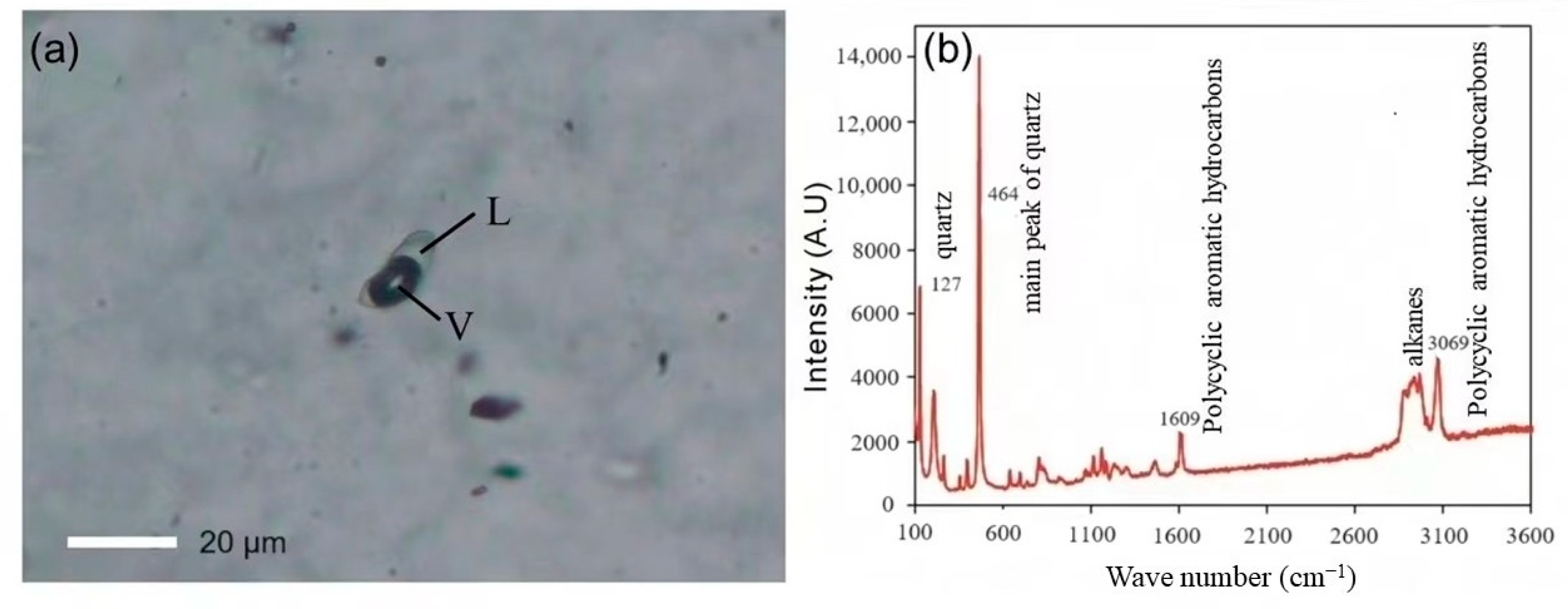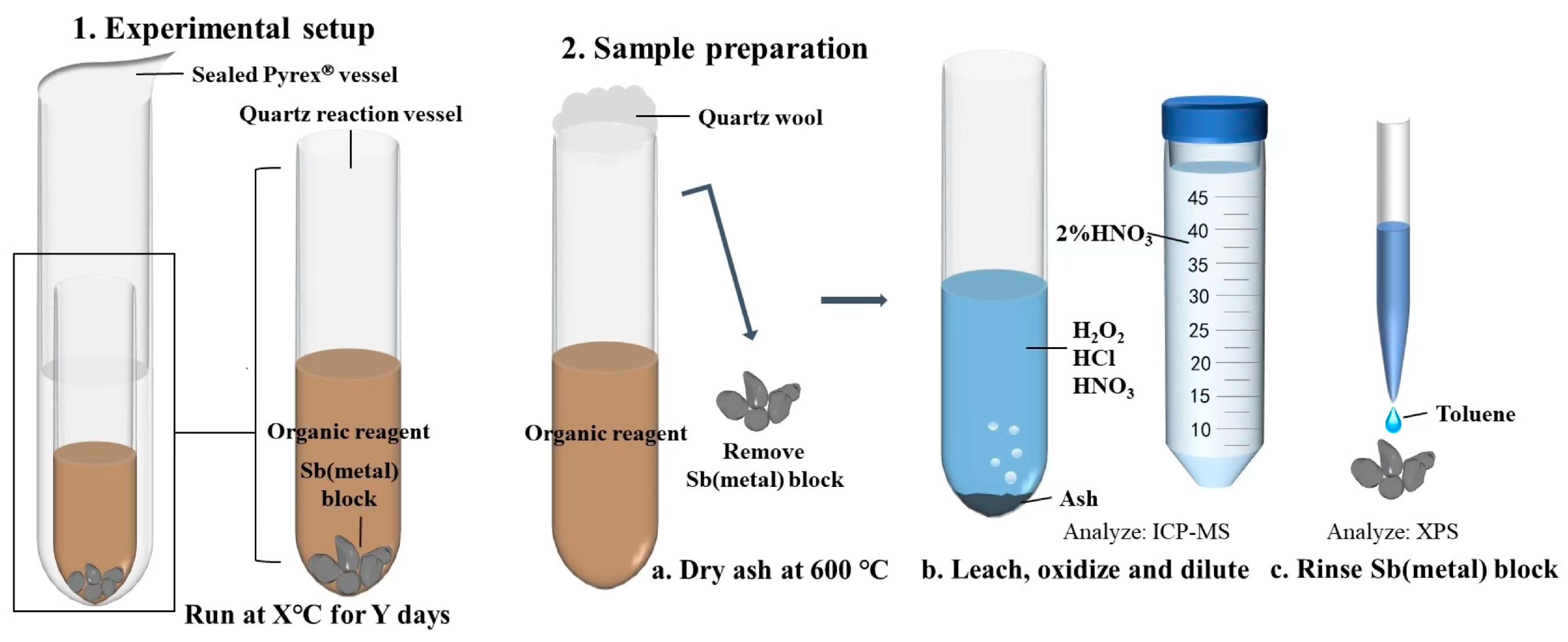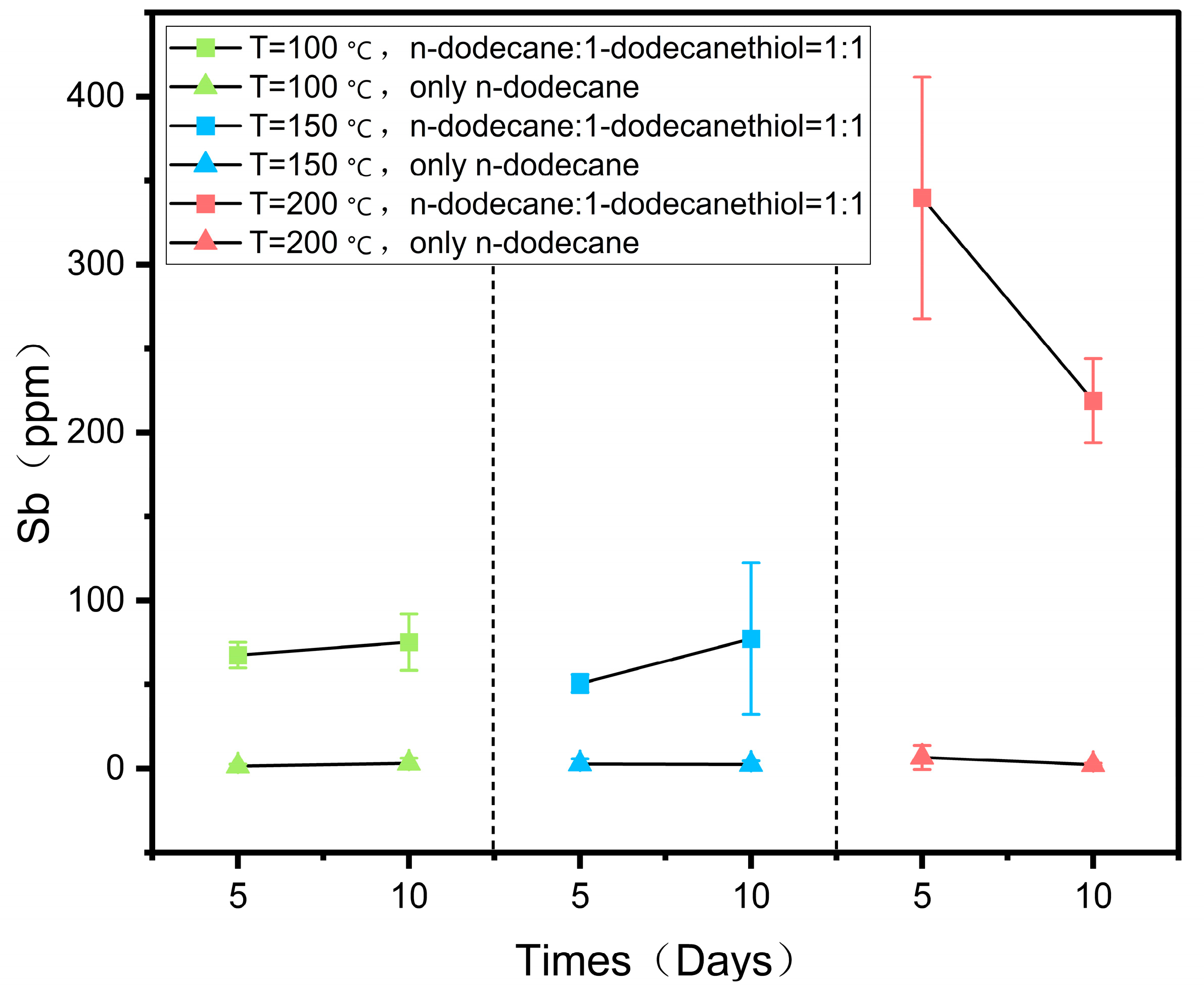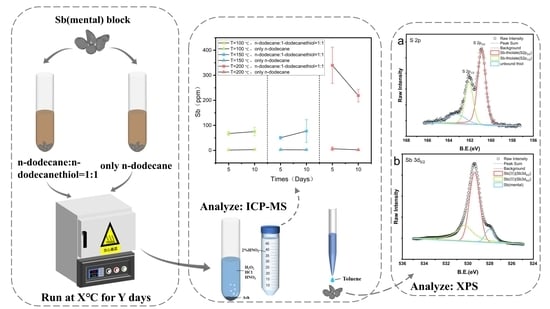The Solubility of Antimony (Sb) in Liquid Hydrocarbons and Its Implication for the Ore-Forming Process of Orogenic Antimony-Gold Deposits in Southern Tibet
Abstract
:1. Introduction
2. Materials and Methods
2.1. Sample Description
2.2. High-Temperature Experiments
2.3. XPS Analysis
3. Results
3.1. Results from the Antimony Solubility Experiments
3.2. Results of XPS Analyses
4. Discussion
4.1. Factors Determining the Concentration and Speciation of Antimony in Liquid Hydrocarbons
4.2. Formation of Liquid Hydrocarbons in Orogenic Antimony-Gold Ores and Their Role in the Mineralization Process
4.3. Evaluation of the Potential of Liquid Hydrocarbons as Ore-Forming Fluids in Orogenic Antimony-Gold Ores
5. Conclusions
- (1)
- Antimony exhibits a pronounced chemical affinity towards reduced sulfur components. The solubility of antimony in organic reagents with a high thiol concentration surpasses its solubility in fluids previously identified as antimony-rich mineralized.
- (2)
- The thermochemical sulfate reaction that occurs in the surrounding rocks of sediment-hosted orogenic antimony-gold deposits in a specific temperature range produces high concentrations of hydrogen sulfide. This, in turn, leads to the formation of a liquid hydrocarbon rich in thiols. This liquid hydrocarbon with a high thiol content can serve as a carrier within the ore-forming fluids for antimony mineralization.
- (3)
- There is a clear positive correlation between the solubility of antimony and thiols, suggesting that thiols are determinants of antimony solubilization in liquid hydrocarbons. Nevertheless, we cannot rule out the possibility that other organic ligands, such as porphyrins and carboxylic acids, may also play a role in the dissolution and transport of antimony.
Author Contributions
Funding
Data Availability Statement
Acknowledgments
Conflicts of Interest
References
- Li, F.; Zhang, G.Y.; Deng, Z.; Zhang, J.F.; Qin, Z.P.; Chen, X.; Lan, Z.W. Mineralization process of the Mazhala Au-Sb deposit, South Tibet: Constraints from fluid inclusions, H-O-S isotopes, and trace elements. Ore Geol. Rev. 2023, 160, 105595. [Google Scholar] [CrossRef]
- Yang, Z.S.; Hou, Z.Q.; Gao, W.; Wang, H.P.; Li, Z.Q.; Meng, X.J.; Qu, X.M. Metallogenic characteristics and genetic model of antimony and gold deposits in south Tibetan detachment system. Acta Geol. Sin. 2006, 80, 1377–1391. [Google Scholar]
- Feng, X.L.; Du, G.S. The distribution, mineralization types and prospecting and exploration of the gold deposits in Xizang. Tethyan Geol. 1999, 23, 31–38. [Google Scholar]
- Sun, X.; Zheng, Y.Y.; Wang, C.M.; Zhao, Z.Y.; Geng, X.B. Identifying geochemical anomalies associated with Sb-Au-Pb-Zn-Ag mineralization in North Himalaya, southern Tibet. Ore Geol. Rev. 2016, 73, 1–12. [Google Scholar] [CrossRef]
- Li, Y.; Song, Y.; Tang, J.X.; Chen, W.; Sun, H. Study on the distribution, type and metallogenic regularity of antimony deposit in Tibet. Geol. China 2023, 1–34. [Google Scholar]
- Fu, J.M.; Peng, P.A.; Lin, Q.; Liu, D.H.; Jia, R.F.; Shi, J.X.; Lu, J.L. A few issues in the study of organic geochemistry of stratified mineral deposits. Adv. Earth Sci. 1990, 5, 43–49. [Google Scholar]
- Zhuang, H.P.; Lu, J.L. Metallogenic deposits associated with organic matter. Geology-Geochemistry 1996, 4, 6–11. [Google Scholar]
- Zhuang, H.P.; Lu, J.L.; Wen, H.J.; Mao, H.H. Organic matter in hydrothermal ore-forming fluid. Geology-Geochemistry 1997, 1, 85–91. [Google Scholar]
- Wan, C.L.; Zhai, Q.L.; Jin, Q. Interaction between source rocks and igneous rocks—A preliminary investigation of dissolution of igneous rocks by organic acids and catalysis of transition metals in the generation of hydrocarbons in the source rocks. Geology-Geochemistry 2001, 29, 46–51. [Google Scholar]
- Miao, Y.N.; Li, X.F.; Wang, X.Z.; Chen, Y.; Zhou, Y.J.; Liu, F.W.; Xia, J. Review on hydrocarbon generation, pores formation and its methane adsorption mechanism in shale kerogen. Sci. Sin. Phys. Mech. Astron. 2017, 47, 114604. [Google Scholar] [CrossRef]
- Mo, R.W.; Sun, X.M.; Zhai, W.; Zhou, F.; Liang, Y.H. Ore-forming fluid geochemistry and metallogenic mechanism from Mazhala gold-antimony deposit in southern Tibet, China. Acta Petrol. Sin. 2013, 29, 1427–1438. [Google Scholar]
- Hu, S.Y.; Evans, K.; Craw, D.; Rempel, K.; Bourdet, J.; Dick, J.; Grice, K. Raman characterization of carbonaceous material in the Macraes orogenic gold deposit and metasedimentary host rocks, New Zealand. Ore Geol. Rev. 2015, 70, 80–95. [Google Scholar] [CrossRef]
- Mirasol-Robert, A.; Grotheer, H.; Bourdet, J.; Suvorova, A.; Grice, K.; McCuaig, T.C.; Greenwood, P.F. Evidence and origin of different types of sedimentary organic matter from a Paleoproterozoic orogenic Au deposit. Precambrian Res. 2017, 299, 319–338. [Google Scholar] [CrossRef]
- Zhai, W.; Zheng, S.Q.; Sun, X.M.; Wei, H.X.; Mo, R.W.; Zhang, L.Y.; Zhou, F.; Yi, J.Z. He-Ar isotope compositions of orogenic Mazhala Au-Sb and Shalagang Sb deposits in Himalayan orogeny, southern Tibet: Constrains to ore-forming fluid origin. Acta Petrol. Sin. 2018, 34, 3525–3538, (In Chinese with English Abstract). [Google Scholar]
- Fuchs, S.; Williams-Jones, A.E.; Jackson, S.E.; Przybylowicz, W.J. Metal distribution in pyrobitumen of the Carbon Leader Reef, Witwatersrand Supergroup, South Africa: Evidence for liquid hydrocarbon ore fluids. Chem. Geol. 2016, 426, 45–59. [Google Scholar] [CrossRef]
- Landais, P. Organic geochemistry of sedimentary uranium ore deposits. Ore Geol. Rev. 1996, 11, 33–51. [Google Scholar] [CrossRef]
- Spirakis, C.S. The roles of organic matter in the formation of uranium deposits in sedimentary rocks. Ore Geol. Rev. 1996, 11, 53–69. [Google Scholar] [CrossRef]
- Parnell, J. Metal enrichments in solid bitumens—A review. Miner. Depos. 1988, 23, 191–199. [Google Scholar] [CrossRef]
- Gize, A.; Barnes, H. Organic processes in Mississippi Valley Type ore genesis. In Proceedings of the 28th International Geological Congress Abstracts, Washington, DC, USA, 9–19 July 1989; pp. 557–558. [Google Scholar]
- Kesler, S.; Jones, H.; Furman, F.; Sassen, R.; Anderson, W.; Kyle, J. Role of crude oil in the genesis of Mississippi Valley Type deposits: Evidence from the Cincinnati arch. Geology 1994, 22, 609–612. [Google Scholar] [CrossRef]
- Ye, Z.Y.; Shi, J.X.; Hu, R.Z. Organic matter and its role in mineralization in DaChang antimony deposit, Guizhou, China. Acta Mineral. Sin. 1997, 3, 310–315. [Google Scholar]
- Wang, P.P. Relationship between organic matters and mineralization in the Qinglong antimony deposit, Guizhou province. Value Eng. 2019, 38, 243–245. [Google Scholar]
- Yan, S.H.; Yu, J.J.; Zhao, Y.X.; Xu, Z.Z.; Wang, A.J.; Teng, R.L. Geology and Geochemistry of the Meiduo Antimony Ore Belt in Northern Tibet: Its Origin and Geodynamic Setting. Acta Geosci. Sin. 2004, 25, 541–548. [Google Scholar]
- Zhang, Z.J.; Zhang, W.H. The study of organic ore-forming fluids in the Lannigou gold (mercury, antimony) deposit, Guizhou Province. Miner. Depos. 1998, 17, 354–361. [Google Scholar]
- Yin, F.G.; Wan, F.; Tang, W.Q. The disseminated gold deposits in southwestern Guizhou: Mineralization model and its correlation with oil-generation theories. Sediment. Geol. Tethyan Geol. 2000, 20, 1–8. [Google Scholar]
- Levine, R. Occurrence of fracture hosted imponite and petroleum fluid inclusion, Quebec city region, Canada. AAPG Bull. 1991, 75, 139–153. [Google Scholar]
- Nie, F.J.; Hu, P.; Jiang, S.H.; Li, Z.Q.; Liu, Y.; Zhou, Y.Z. Type and temporal-spatial distribution of gold and antimony deposits (prospects) in southern Tibet, China. Acta Geol. Sin. 2005, 3, 373–385. [Google Scholar]
- Migdisov, A.A.; Guo, X.; Xu, H.; Williams-Jones, A.E.; Sun, C.J.; Vasyukova, O.; Sugiyama, I.; Fuchs, S.; Pearce, K.; Roback, R. Hydrocarbons as ore fluids. Geochem. Perspect. Lett. 2017, 5, 47–52. [Google Scholar] [CrossRef]
- Crede, L.S.; Evans, K.A.; Rempel, K.U.; Grice, K.; Sugiyama, I. Gold partitioning between 1-dodecanethiol and brine at elevated temperatures: Implications of Au transport in hydrocarbons for oil-brine ore systems. Chem. Geol. 2019, 504, 28–37. [Google Scholar] [CrossRef]
- Crede, L.S.; Liu, W.; Evans, K.A.; Rempel, K.U.; Testemale, D.; Brugger, J. Crude oils as ore fluids: An experimental in-situ XAS study of gold partitioning between brine and organic fluid from 25 to 250 °C. Geochim. Cosmochim. Acta 2019, 244, 352–365. [Google Scholar] [CrossRef]
- Sanz-Robinson, J.; Williams-Jones, A.E. Zinc solubility, speciation and deposition: A role for liquid hydrocarbons as ore fluids for Mississippi Valley Type Zn-Pb deposits. Chem. Geol. 2019, 520, 60–68. [Google Scholar] [CrossRef]
- Sanz-Robinson, J.; Sugiyama, I.; Williams-Jones, A.E. The solubility of palladium (Pd) in crude oil at 150, 200 and 250 °C and its application to ore genesis. Chem. Geol. 2020, 531, 119320. [Google Scholar] [CrossRef]
- Kubrakova, I.V.; Nabiullina, S.N.; Pryazhnikov, D.V.; Kiseleva, M.S. Organic matter as a forming and transporting agent in transfer processes of PGE and gold. Geochem. Int. 2022, 60, 748–756. [Google Scholar] [CrossRef]
- Crede, L.S.; Rempel, K.U.; Hu, S.Y.; Evans, K.A. An experimental method for gold partitioning between two immiscible fluids: Brine and n-dodecane. Chem. Geol. 2018, 501, 35–50. [Google Scholar] [CrossRef]
- Sugiyama, I.; Williams-Jones, A.E. An approach to determining nickel, vanadium and other metal concentrations in crude oil. Anal. Chim. Acta 2018, 1002, 18–25. [Google Scholar] [CrossRef]
- Castner, D.G.; Hinds, K.; Grainger, D.W. X-ray photoelectron spectroscopy sulfur 2p study of organic thiol and disulfide binding interactions with gold surfaces. Langmuir 1996, 12, 5083–5086. [Google Scholar] [CrossRef]
- Kolpakova, H.H.; Mapucharyants, B.O.; Zhang, F.X. Physicochemical conditions responsible for antimony and gold-antimony mineralization. Geology-Geochemistry 1993, 5, 17–22. [Google Scholar]
- He, J.; Ma, D.S.; Liu, Y.J. Geochemistry of mineralization in the Zhazixi antimony ore belt on the margin of the Jiangnan old land. Miner. Depos. 1996, 15, 41–52. [Google Scholar]
- Williams-Jones, A.E.; Norman, C. Controls of mineral parageneses in the system Fe-Sb-S-O. Econ. Geol. 1997, 92, 308–324. [Google Scholar] [CrossRef]
- Lu, J.L.; Yuan, Z.Q. Experimental studies of organic-Zn complexes and their stability. Chin. J. Geochem. 1986, 5, 369–380. [Google Scholar]
- Lewan, M. Factors controlling the proportionality of vanadium to nickel in crude oils. Geochim. Cosmochim. Acta 1984, 48, 2231–2238. [Google Scholar] [CrossRef]
- Giordano, T.H. Metal transport in ore fluids by organic ligand complexation. In Organic Acids in Geological Processes; Springer: Berlin, Heidelberg, 1994; pp. 319–354. [Google Scholar]
- Ho, T.Y.; Rogers, M.A.; Drushel, H.V.; Koons, C.B. Evolution of sulfur compounds in crude oils. AAPG Bull. 1974, 58, 2338–2348. [Google Scholar]
- Wei, Z.; Mankiewicz, P.; Walters, C.; Qian, K.; Phan, N.T.; Madincea, M.E.; Nguyen, P.T. Natural occurrence of higher thiadiamondoids and diamondoidthiols in a deep petroleum reservoir in the Mobile Bay gas field. Org. Geochem. 2011, 42, 121–133. [Google Scholar] [CrossRef]
- Cai, C.; Worden, R.H.; Bottrell, S.H.; Wang, L.; Yang, C. Thermochemical sulphate reduction and the generation of hydrogen sulphide and thiols (mercaptans) in Triassic carbonate reservoirs from the Sichuan Basin, China. Chem. Geol. 2003, 202, 39–57. [Google Scholar] [CrossRef]
- Nguyen, V.P.; Burklé-Vitzthum, V.; Marquaire, P.M.; Michels, R. Thermal reactions between alkanes and H2S or thiols at high pressure. J. Anal. Appl. Pyrolysis 2013, 103, 307–319. [Google Scholar] [CrossRef]
- Kaneko, Y.; Katayama, I.; Yamamoto, H.; Misawa, K.; Ishikawa, M.; Rehman, H.U.; Kausar, A.B.; Shiraishi, K. Timing of Himalayan ultrahigh-pressure metamorphism: Sinking rate and subduction angle of the Indian continental crust beneath Asia. J. Metamorph. Geol. 2003, 21, 589–599. [Google Scholar] [CrossRef]
- Leech, M.; Singh, S.; Jain, A.; Klemperer, S.; Manickavasagam, R. The onset of India- Asia continental collision: Early, steep subduction required by the timing of UHP metamorphism in the western Himalaya. Earth Planet. Sci. Lett. 2005, 234, 83–97. [Google Scholar] [CrossRef]
- Hou, Z.Q.; Qu, X.M.; Yang, Z.S.; Meng, X.J.; Li, Z.Q.; Yang, Z.M.; Zheng, M.P.; Zheng, Y.Y.; Nie, F.J.; Gao, Y.F.; et al. Metallogenesis in Tibetan collisional orogenic belt: III. Mineralization in post-collisional extension setting. Miner. Depos. 2006, 25, 629–651. [Google Scholar]
- Burchfie, B.C.; Chen, Z.; Hodges, K.V.; Liu, Y.P.; Royden, L.H.; Deng, C.R.; Xu, J.N. The south Tibetan detachment system, Himalayan orogen: Extension contemporaneous with and parallel to shortening in a collisional mountain belt. Geol. Soc. Am. Spec. Paper 1992, 269, 1–41. [Google Scholar]
- Schares, E.; Xu, R.H.; Allegere, C.J. U-Pb geochronology of the Gangdese (Transhimalaya) plutonism in the Lhasa-Xizang region, Tibet. Earth Planet. Sci. Lett. 1984, 69, 311–320. [Google Scholar] [CrossRef]
- Harrison, T.M.; McKeegan, K.D.; LeFort, P. Detection of inherited monazite in the Manaslu leucogranite by 208Pb/232Th ion microprobe dating: Crystallization age and tectonic implications. Earth Planet. Sci. Lett. 1995, 133, 271–282. [Google Scholar] [CrossRef]
- Hou, Z.Q.; Gao, Y.F.; Qu, X.M.; Rui, Z.Y.; Mo, X.X. Origin of adakitic intrusives generated during mid-Miocene east-west extension in southern Tibet. Earth Planet. Sci. Lett. 2004, 220, 139–155. [Google Scholar] [CrossRef]
- Zheng, Y.Y.; Wang, D.; Yi, J.Z.; Yu, Z.Z.; Jiang, Z.Y.; Li, X.X.; Shi, G.W.; Xu, J.; Liang, Y.C.; Dou, X.F.; et al. Antimony mineralization and prospecting orientation in the north Himalayan metallogenic belt, Tibet. Earth Sci. Front. 2022, 29, 200–230. [Google Scholar]
- Zhai, W.; Sun, X.M.; Yi, J.Z.; Zhang, X.G.; Mo, R.W.; Zhou, F.; Wei, H.X.; Zeng, Q.G. Geology, geochemistry, and genesis of orogenic gold-antimony mineralization in the Himalayan Orogen, South Tibet, China. Ore Geol. Rev. 2014, 58, 68–90. [Google Scholar] [CrossRef]
- Hu, X.W. Characteristics and discussion of stibnite solubility in different solutions. Miner. Resour. 1994, 201, 33–42. [Google Scholar]
- Zhang, T.Y.; Li, C.Y.; Sun, S.J.; Hao, X.L. Geochemical characteristics of antimony and genesis of antimony deposits in South China. Acta Petrol. Sin. 2020, 36, 44–54, (In Chinese with English Abstract). [Google Scholar]
- Wood, S.A.; Crerar, D.A.; Borcsik, M.P. Solubility of the assemblage pyrite-pyrrhotite-magnetite-sphalerite-galena-gold-stibnite-bismuthinite-argen-tite-molybdenite in H2O-NaCl-CO2 solutions from 200-350 °C. Econ. Geol. 1987, 82, 1864–1887. [Google Scholar] [CrossRef]
- Williams-Jones, A.E.; Bowell, R.J.; Migdisov, A.A. Gold in solution. Elements 2009, 5, 281–287. [Google Scholar] [CrossRef]
- Yi, J.B. A preliminary study on the basic features of global antimony mineralization and the background of mega antimony deposits in the world. Geotecton. Metallog. 1994, 3, 199–208. [Google Scholar]
- Machel, H.G. Bacterial and thermochemical sulfate reduction in diagenetic settings—Old and new insights. Sediment. Geol. 2001, 140, 143–175. [Google Scholar] [CrossRef]





| Parameters | N-Dodecane | N-Dodecanethiol |
|---|---|---|
| Concentration | AR, 98.0% | AR, 98.0% |
| Density (25 °C) | 0.75 g/mL | 0.845 g/mL |
| Molecular formula | C12H26 | C12H26S |
| Molecular weight | 170.34 | 202.40 |
| Boiling point | 215–217 °C | 266–283 °C |
| Melting point | −9.6 °C | −7 °C |
| Times | N-Dodecane: N-Dodecanethiol = 1:1 | Only N-Dodecane | |||
|---|---|---|---|---|---|
| Temp. | 5 Days | 10 Days | 5 Days | 10 Days | |
| 100 °C | 67.44 ± 7.62 | 75.15 ± 16.74 | 1.40 ± 1.02 | 3.02 ± 3.09 | |
| 150 °C | 50.58 ± 5.39 | 77.26 ± 45.20 | 2.66 ± 3.08 | 2.41 ± 2.03 | |
| 200 °C | 339.76 ± 71.94 | 218.97 ± 25.03 | 6.53 ± 7.17 | 2.27 ± 0.82 | |
Disclaimer/Publisher’s Note: The statements, opinions and data contained in all publications are solely those of the individual author(s) and contributor(s) and not of MDPI and/or the editor(s). MDPI and/or the editor(s) disclaim responsibility for any injury to people or property resulting from any ideas, methods, instructions or products referred to in the content. |
© 2024 by the authors. Licensee MDPI, Basel, Switzerland. This article is an open access article distributed under the terms and conditions of the Creative Commons Attribution (CC BY) license (https://creativecommons.org/licenses/by/4.0/).
Share and Cite
Su, Y.; Sun, X.; Ding, Z. The Solubility of Antimony (Sb) in Liquid Hydrocarbons and Its Implication for the Ore-Forming Process of Orogenic Antimony-Gold Deposits in Southern Tibet. Minerals 2024, 14, 141. https://doi.org/10.3390/min14020141
Su Y, Sun X, Ding Z. The Solubility of Antimony (Sb) in Liquid Hydrocarbons and Its Implication for the Ore-Forming Process of Orogenic Antimony-Gold Deposits in Southern Tibet. Minerals. 2024; 14(2):141. https://doi.org/10.3390/min14020141
Chicago/Turabian StyleSu, Yue, Xiaoming Sun, and Zhengpeng Ding. 2024. "The Solubility of Antimony (Sb) in Liquid Hydrocarbons and Its Implication for the Ore-Forming Process of Orogenic Antimony-Gold Deposits in Southern Tibet" Minerals 14, no. 2: 141. https://doi.org/10.3390/min14020141






